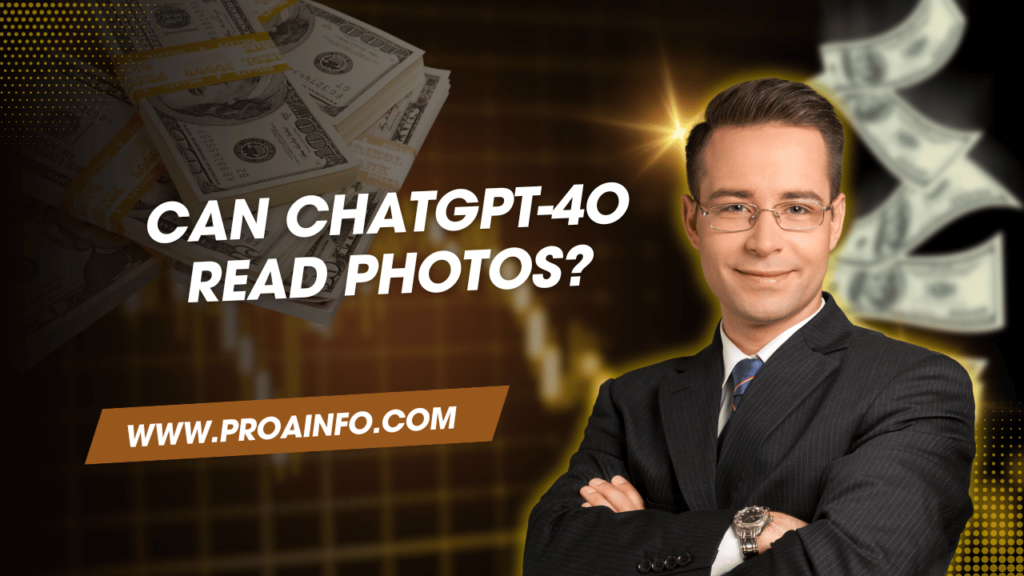Can Chatgpt-4O Read Photos? In the rapidly evolving field of artificial intelligence (AI), one of the most intriguing and challenging areas is computer vision – the ability of machines to interpret and understand visual information.
As AI systems become more advanced, their capabilities to process and analyze images and videos are expanding, opening up new possibilities and applications across various industries.
One of the most anticipated developments in this domain is the potential for AI language models, such as ChatGPT-4O, to not only process and generate text but also comprehend and interpret visual data. This raises an exciting question: Can ChatGPT-4O read photos?
Understanding ChatGPT-4O and Its Capabilities
Before delving into the specifics of ChatGPT-4O’s image recognition capabilities, it’s essential to understand what it is and how it works.
ChatGPT-4O is an advanced language model developed by Anthropic, a renowned AI research company. It is part of the GPT (Generative Pre-trained Transformer) family of models, which are trained on vast amounts of text data from the internet to learn patterns and relationships in language.
Unlike its predecessors, which were primarily focused on text generation and understanding, ChatGPT-4O is designed to be a multimodal AI system, capable of processing and integrating various forms of data, including text, images, and potentially even audio and video.
The Importance of Multimodal AI
The ability to process and understand multimodal data is crucial for AI systems to achieve a more comprehensive and human-like understanding of the world around them. In real-life scenarios, information is often presented in multiple formats, such as text accompanied by images, diagrams, or videos.
Multimodal AI systems like ChatGPT-4O have the potential to bridge the gap between different data modalities, enabling more natural and seamless interactions with users. By understanding the context and meaning conveyed through various forms of data, these systems can provide more accurate and relevant responses, enhancing their usefulness and applicability across a wide range of domains.
Image Recognition and Computer Vision Techniques
Before examining ChatGPT-4O’s specific capabilities, it’s important to understand the underlying techniques and approaches used in image recognition and computer vision.
Convolutional Neural Networks (CNNs)
Convolutional Neural Networks (CNNs) are a type of deep learning architecture that has proven highly effective in image recognition tasks. CNNs are designed to automatically learn and extract relevant features from images, enabling them to classify, detect, and segment objects within visual data.
Object Detection and Segmentation
Object detection involves identifying and localizing specific objects within an image, while object segmentation goes a step further by precisely delineating the boundaries of those objects. These techniques are crucial for applications such as autonomous vehicles, surveillance systems, and medical imaging analysis.
Image Captioning
Image captioning is the task of automatically generating textual descriptions for images, providing a natural language understanding of the visual content. This technique combines computer vision and natural language processing, allowing AI systems to describe the relevant objects, actions, and relationships depicted in an image.
Visual Question Answering (VQA)
Visual Question Answering (VQA) is an emerging field that combines computer vision and natural language processing to enable AI systems to answer questions about visual data. This involves understanding the content of an image or video and reasoning about it to provide accurate and relevant answers to user queries.
ChatGPT-4O’s Image Recognition Capabilities
Now, let’s explore the specific capabilities of ChatGPT-4O when it comes to reading and understanding photos.
Integration of Computer Vision Models
To enable image recognition capabilities, ChatGPT-4O is likely to incorporate state-of-the-art computer vision models, such as CNNs and object detection algorithms. These models are pre-trained on large datasets of images and can accurately identify and classify objects, scenes, and activities within visual data.
Multimodal Learning
One of the key advantages of ChatGPT-4O is its ability to learn from and integrate multimodal data during training. This means that the model is exposed to both text and visual data, allowing it to learn the relationships and connections between language and visual information.
By leveraging multimodal learning techniques, ChatGPT-4O can develop a deeper understanding of the context and meaning conveyed through images, enabling it to provide more accurate and relevant responses when presented with visual data.
Image Captioning and Visual Question Answering
Powered by its multimodal learning capabilities, ChatGPT-4O is expected to excel at tasks such as image captioning and visual question answering. When presented with an image, the model can generate descriptive captions that accurately describe the content, objects, and activities depicted.
Furthermore, users can ask questions related to the visual data, and ChatGPT-4O can provide relevant answers by analyzing the image and combining its understanding with its vast knowledge base.
Contextual Understanding and Reasoning
One of the key strengths of ChatGPT-4O is its ability to understand and reason about context. When presented with an image, the model can leverage its knowledge to interpret the visual information in the appropriate context, considering factors such as the surrounding text, user intent, and domain-specific knowledge.
This contextual understanding allows ChatGPT-4O to provide more meaningful and relevant responses, going beyond simple object recognition and delving into deeper analysis and insights.
Applications and Use Cases
The ability of ChatGPT-4O to read and understand photos opens up a wide range of applications and use cases across various industries and domains.
E-commerce and Product Search
In the e-commerce sector, ChatGPT-4O can revolutionize product search and recommendation systems. Users can upload images of products they are interested in, and the AI system can analyze the visual data, identify the product, and provide relevant information, such as product details, pricing, and similar recommendations.
Healthcare and Medical Imaging
In the healthcare industry, ChatGPT-4O’s image recognition capabilities can be invaluable for medical imaging analysis. Radiologists and physicians can upload medical scans and images, and the AI system can assist in detecting and diagnosing conditions, identifying abnormalities, and providing insights to support clinical decision-making.
Education and Visual Learning
In the field of education, ChatGPT-4O can enhance visual learning experiences. Students can upload images or diagrams related to their studies, and the AI system can provide explanations, additional context, and interactive learning opportunities based on the visual content.
Accessibility and Assistive Technologies
For individuals with visual impairments or disabilities, ChatGPT-4O’s image recognition capabilities can serve as a powerful assistive technology. By describing the content of images or scenes, the AI system can provide greater access to visual information, enabling more inclusive and accessible experiences.
Creative Industries and Art Analysis
In the creative industries, such as art, design, and advertising, ChatGPT-4O can be used for visual analysis and insights. Artists, curators, and art historians can leverage the AI system to analyze and interpret artworks, identifying styles, techniques, and influences, as well as gaining deeper understanding and appreciation of visual works.
Challenges and Limitations
While the potential of ChatGPT-4O to read and understand photos is exciting, there are also challenges and limitations that need to be addressed.
Bias and Fairness
Like any AI system, ChatGPT-4O may be susceptible to biases present in the training data or the algorithms used. Ensuring fairness and avoiding discriminatory or unethical outcomes when processing visual data is a critical consideration.
Privacy and Security Concerns
As ChatGPT-4O processes and analyzes visual data, there may be privacy and security concerns related to the handling and storage of sensitive or personal information contained within images or videos.
Interpretability and Explainability
While ChatGPT-4O may be capable of accurately recognizing and understanding visual content, the inner workings of its decision-making process may not be easily interpretable or explainable, particularly for complex visual scenes or edge cases.
Computational Resources and Scalability
Processing and analyzing visual data at scale can be computationally intensive, requiring significant hardware resources and efficient algorithms. Ensuring the scalability and performance of ChatGPT-4O’s image recognition capabilities as the volume and complexity of visual data increase is a key challenge.
Future Developments and Research Directions
The field of multimodal AI and image recognition is rapidly evolving, and there are several exciting developments and research directions that could further enhance the capabilities of systems like ChatGPT-4O.
Continuous Learning and Adaptation
As new visual data becomes available, ChatGPT-4O should be capable of continuous learning and adaptation, updating its knowledge and improving its performance over time without the need for complete retraining.
Here’s the continuation of the article:
Multimodal Reasoning and Inference
Beyond recognizing and understanding individual modalities, future research aims to develop AI systems that can effectively reason and make inferences by combining and integrating information from multiple modalities, such as text, images, and audio/video. This multimodal reasoning capability would allow for more comprehensive and accurate analysis and decision-making in complex real-world scenarios.
Unsupervised and Self-Supervised Learning
While current image recognition models rely heavily on supervised learning, where large datasets of labeled images are required for training, future research is exploring unsupervised and self-supervised learning techniques. These approaches aim to leverage the vast amounts of unlabeled visual data available, enabling AI systems to learn and extract meaningful representations and patterns without the need for extensive manual annotation.
Explainable AI and Interpretability
As AI systems become more capable and are deployed in high-stakes decision-making scenarios, there is a growing emphasis on explainable AI and interpretability. Research efforts are focused on developing techniques that can provide insights into the decision-making process of AI models, making their reasoning more transparent and interpretable to human users.
Multimodal Generation and Creation
While the focus has been on understanding and analyzing multimodal data, future research may also explore the generative capabilities of AI systems like ChatGPT-4O. This could involve generating realistic and coherent images, videos, or even interactive experiences based on textual or multimodal inputs, opening up new possibilities in fields such as creative design, entertainment, and virtual/augmented reality.
Ethical Considerations and Responsible AI
As AI systems become more advanced and pervasive, there is a growing need to address ethical considerations and ensure the responsible development and deployment of these technologies. Research efforts should prioritize issues such as privacy, bias mitigation, transparency, and accountability, to ensure that AI systems like ChatGPT-4O are developed and used in a manner that aligns with societal values and ethical principles.
Conclusion
The potential for ChatGPT-4O to read and understand photos represents a significant milestone in the field of artificial intelligence. By integrating computer vision and natural language processing capabilities, this advanced AI system can bridge the gap between different modalities, enabling more natural and seamless interactions with users.
As the capabilities of ChatGPT-4O and similar multimodal AI systems continue to evolve, we can expect to see a transformative impact across various industries and domains, from e-commerce and healthcare to education and creative endeavors.
However, it’s crucial to address the challenges and limitations associated with these technologies, such as bias, privacy concerns, interpretability, and computational scalability. Ongoing research and development efforts should prioritize not only advancing the technical capabilities but also ensuring the responsible and ethical deployment of these powerful AI systems.
Ultimately, the ability of ChatGPT-4O to read photos is just one step towards a future where AI systems can seamlessly integrate and reason across multiple modalities, providing a more comprehensive and human-like understanding of the world around us.
FAQs
What types of images can ChatGPT-4O recognize?
ChatGPT-4O is expected to have the capability to recognize and understand a wide range of image types, including photographs, illustrations, diagrams, charts, and various visual representations. Its image recognition capabilities are likely to span multiple domains, such as natural scenes, objects, products, medical imagery, and more.
How accurate is ChatGPT-4O’s image recognition?
The accuracy of ChatGPT-4O’s image recognition capabilities will depend on various factors, including the complexity of the visual data, the quality and resolution of the images, and the specific task or application. However, given the advancements in computer vision and multimodal AI, it is expected to achieve state-of-the-art performance, comparable to or potentially surpassing current leading image recognition models.
Can ChatGPT-4O recognize handwritten text or symbols in images?
Yes, ChatGPT-4O is likely to have the ability to recognize and interpret handwritten text, symbols, and annotations within images. This capability, known as optical character recognition (OCR), is essential for applications such as document processing, sign recognition, and analyzing handwritten notes or diagrams.
How does ChatGPT-4O combine text and visual information?
ChatGPT-4O’s multimodal learning capabilities allow it to integrate and reason about information from multiple modalities, including text and visual data. When presented with an image and accompanying text or context, the AI system can combine its understanding of the visual content with the textual information to provide more accurate and relevant responses.
Can ChatGPT-4O generate descriptions or captions for images?
One of the key capabilities of ChatGPT-4O is image captioning, which involves generating textual descriptions or captions for visual data. When presented with an image, the AI system can analyze the content and generate natural language descriptions that accurately describe the objects, scenes, activities, and relevant details depicted in the image.
How does ChatGPT-4O handle privacy and security concerns related to image data?
Privacy and security are crucial considerations when dealing with visual data, as images may contain sensitive or personal information. ChatGPT-4O and its developers will need to implement robust measures to protect user privacy, such as data encryption, access controls, and secure storage and transmission of image data. Additionally, appropriate policies and guidelines should be in place to ensure ethical and responsible handling of visual information.
Can ChatGPT-4O be used for visual search or product recommendations?
Yes, ChatGPT-4O’s image recognition capabilities can be leveraged for visual search and product recommendation applications. Users can upload or share images of products they are interested in, and the AI system can analyze the visual data, identify the product, and provide relevant information, recommendations, and suggestions based on the user’s preferences and context.
How does ChatGPT-4O’s image recognition capability compare to human performance?
While ChatGPT-4O’s image recognition capabilities are expected to be highly advanced, it is difficult to make direct comparisons to human performance. Humans have a unique ability to understand context, reason abstractly, and integrate multiple sources of information, which may still give them an advantage in certain tasks or scenarios. However, for specific tasks like object recognition or visual pattern detection, AI systems like ChatGPT-4O may outperform humans in terms of speed, accuracy, and consistency.







